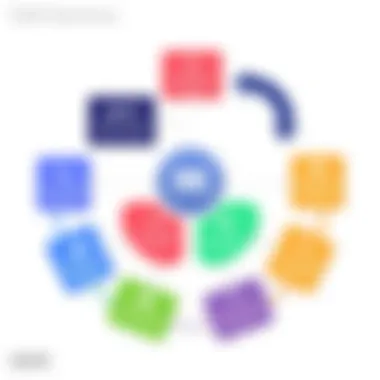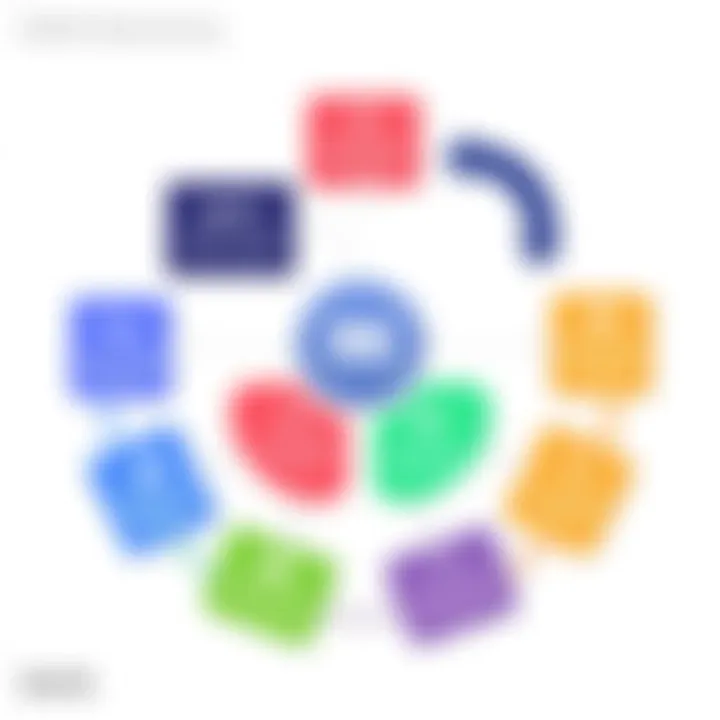Comparative Analysis of OKR Software Solutions


Intro
In today’s fast-paced business climate, employing the right tools for strategic alignment is not just an option; it's a necessity. Organizations are increasingly turning to OKR (Objectives and Key Results) software to steer their teams toward a common goal. With a multitude of options available in the market, decision-makers face the daunting task of selecting the software that best fits their unique needs. This analysis peels back the layers of various OKR software choices and lays out a clear path for understanding what each stands to offer.
Exploring these platforms provides insight into their capabilities, helping you to identify which software aligns seamlessly with your company’s vision. This aids not just in tracking performance but also in fostering a culture of transparency and accountability across all levels of an organization.
Our journey through an array of features, benefits, and potential pitfalls enables savvy leaders to assess options critically. Rather than preserving the status quo, these insights encourage innovation and goal-driven performance within small to medium-sized businesses, empowering entrepreneurial spirits and IT professionals alike.
Key Features of the Software
Effective OKR software does more than display goals; it serves as a powerhouse of functionalities designed to uplift organizational performance. Let’s take a closer look at the core features you should consider.
Overview of Core Functionalities
Most OKR tools share fundamental capabilities, but nuances can make all the difference. Here’s what to look for:
- Goal Setting: A user-friendly interface that enables you to set, edit, and manage objectives with ease.
- Progress Tracking: Real-time updates that show how close you are to each goal without endless back-and-forth emails.
- Collaborative Features: Tools that allow team members to contribute, comment, and engage around shared objectives, providing a sense of ownership and motivation.
- Integration Options: The ability to seamlessly integrate with other tools like project management software (think Asana or Trello) and communication platforms (like Slack), ensuring all your data talks to each other.
Unique Selling Points
While many platforms offer similar functionalities, some shine with unique selling propositions that set them apart. Consider the following:
- Customization: Certain software solutions allow for extensive customization options, tailoring the interface and reporting features to meet the specific requirements of your organization.
- User Analytics: Some tools offer advanced analytics capabilities, enabling leaders to dig deeper into performance data and make decisions based on trends and KPI correlations.
- Mobile Access: Having an app that allows users to manage their OKRs on the go makes the software more appealing for teams in a fast-moving world.
In-Depth Software Analysis
Evaluating OKR tools requires more than a checklist of features; it demands a closer look at tangible benefits and drawbacks.
Pros and Cons
Understanding the upsides and downsides can greatly influence your choice:
- Pros:
- Cons:
- Fosters alignment across teams, promoting a unified direction.
- Enhances accountability by assigning key results to specific individuals.
- Provides a clear foundation for performance review discussions.
- Some tools can be overwhelming for small teams reeling from the sheer volume of available options.
- Not every platform offers the same level of customer support, which can stall implementation.
Performance Metrics
When assessing the performance of OKR software, it’s crucial to look beyond user experiences. Here are important performance metrics to consider:
- User Adoption Rate: Measure how quickly and effectively teams are utilizing the features.
- Goal Achievement Rate: Data on the percentage of objectives met within a designated timeframe.
- Feedback on Usability: Consistent user satisfaction ratings gathered through surveys or feedback forms can reveal deeper insights.
A well-informed choice in OKR software can propel an organization toward strategic success and employee satisfaction, reflecting on the bottom line vividly.
Prelude to OKR Software
In today’s fast-paced business environment, where every decision can tip the scales of success, understanding OKR software becomes paramount. Objectives and Key Results (OKR) is not just a buzzword; it's a powerful framework that can drive organizations toward their strategic goals. As many businesses leap into this realm, the right software can make all the difference in achieving clarity and alignment throughout the organization.
Understanding OKRs
OKRs consist of two main parts: objectives, which are what you want to achieve, and key results, which measure progress towards those objectives. It’s a simple yet compelling system. For instance, a marketing team might set an objective to "increase brand awareness," with key results such as "boost website traffic by 30%" or "gain 500 new social media followers." By breaking down lofty targets into measurable chunks, organizations gain a clearer focus and can align efforts across teams.
Employing OKRs effectively encourages teal collaboration and engagement. Teams feel empowered when they can track their contributions to shared objectives. Additionally, this method fosters transparency; everyone knows what is happening and how it connects back to the bigger picture.
Importance of OKR Software
With the growing adoption of the OKR framework, many businesses find themselves looking at software solutions to streamline this process. The importance of OKR software cannot be overstated. It serves as the backbone for tracking, managing, and aligning the different pieces of an organization’s strategy.
Key benefits of using OKR software include:
- Centralized Tracking: Rather than dispersed spreadsheets and emails, a dedicated platform keeps all objectives and results in one place, simplifying oversight.
- Real-time Updates: Unlike quarterly reviews, many OKR tools allow for live adjustments and updates. This enables organizations to pivot when necessary and stay on course.
- Performance Insights: With built-in analytics, businesses can gather valuable insights on their progress, identifying what works and what doesn’t.
As small to medium-sized businesses and entrepreneurs, adopting OKR software positions you ahead of the curve. It provides structure and ensures every team is rowing in the same direction, ultimately contributing to a healthier organizational culture and improved bottom lines.
"The most effective way to manage change is to create it." – Peter F. Drucker
In a nutshell, OKR software is more than just a tool; it's a strategic ally in navigating toward organizational success.


Criteria for Software Comparison
When it comes to selecting OKR software, establishing clear criteria for comparison is crucial. In a market filled with options, decision-makers must sift through myriad features, pricing structures, and user experiences. This section provides a framework to assess software capabilities, ensuring that the final choice aligns with organizational goals and user requirements. Each criterion serves not just as a benchmark, but as a lens through which businesses can gauge their needs against what’s available.
Feature Set and Functionality
The first aspect to consider when comparing OKR software is the feature set and functionality it offers. Different organizations have varied ambitions and ways of working, which means the right software must have capabilities that align with these diverse needs. For example, some teams might prioritize real-time progress tracking, while others might emphasize the importance of collaboration tools or report generation features. A robust OKR software should include functionalities like:
- Goal setting tools for creating and managing objectives.
- Metrics and key results tracking designed to visualize progress.
- Collaboration capabilities, allowing teams to work together seamlessly.
- Reporting and analytics features that provide insights on performance over time.
- Customizability to tailor the software to fit specific use cases or methodologies.
Having a clear understanding of the essential features required for your organization will significantly influence software selection.
User Experience and Interface Design
User experience plays a pivotal role in how effectively a team can utilize an OKR tool. If the software is tedious to navigate, it can quickly become a bottleneck rather than a facilitator of productivity. An intuitive interface can make a world of difference. Key considerations include:
- Ease of navigation: Users should be able to find what they need without excessive clicks.
- Visual appeal: Engaging and pleasant designs can enhance user satisfaction.
- Accessibility: The interface should be user-friendly for individuals with varying levels of tech-savviness.
- Mobile functionality: As remote work continues, having robust mobile availability becomes increasingly important.
Incorporating user feedback on design can also aid in assessing how well a software meets the expectations of its users.
Integration Capabilities
In today’s business landscape, software seldom exists in isolation. Therefore, integration capabilities are a fundamental aspect of OKR software evaluation. The chosen solution should seamlessly connect with other tools utilized by the organization, spanning project management, CRM systems, and communication platforms. Considerations include:
- Availability of plugins or API access for effortless integration.
- Cross-platform compatibility to ensure smooth data flow across various applications.
- Documentation and support from the software provider for any integration challenges.
A software that fits well into an existing tech stack can greatly enhance productivity and reduce friction in workflows.
Cost Considerations
Cost is often one of the more immediate concerns for businesses when evaluating different OKR software. It’s not merely about the sticker price, but a more nuanced analysis of value for money. Elements to evaluate may include:
- Subscription models: Monthly vs. annual plans; bulk pricing for larger teams.
- Hidden costs: Look out for fees related to training, support, or feature upgrades.
- Cost-to-value ratio: Does the software deliver sufficient features to justify its cost?
Understanding the long-term financial implications of software investment is essential for making a sound decision.
Customer Support and Resources
Lastly, strong customer support is an invaluable asset when adopting any software solution. Organizations should assess the level of assistance offered by the provider. Essential aspects encompass:
- Availability of support channels, such as live chat, email, or phone support.
- Access to training materials like webinars, tutorials, and documentation.
- Community support: Forums or user groups that can facilitate knowledge sharing among users.
An effective support system not only eases the transition process but also enhances user satisfaction long after deployment.
The criteria for software comparison forms the backbone of effective decision-making in the pursuit of the right OKR software, ensuring each organization can find a solution tailored to its particular needs.
Leading OKR Software Solutions
In the current business landscape, the criticality of aligning objectives and tracking key results cannot be overstated. Utilizing the right OKR software is not just about ticking boxes on a checklist; it’s about finding a partner in the goal-setting journey that enhances productivity and fosters organizational growth. This section aims to present a thorough examination of leading OKR software solutions available in the market, showcasing their unique offerings, and identifying which tools make the cut for the most effectiveness based on diverse business requirements.
Software A Overview
Key Features
Software A stands out due to its robust tracking capabilities, allowing users to visualize progress in real time. Its intuitive dashboard is designed with user experience in mind, making it a favorite among teams new to the OKR philosophy. One particular characteristic that enhances its attractiveness is the customizable templates for setting objectives. Users can tailor these templates to match their specific needs, thus optimizing the framework for aligning team goals with broader organizational aspirations. However, some users have pointed out that this software occasionally lacks advanced analytics tools, which could limit deeper insights into performance trends.
Pricing Structure
The pricing plan for Software A is designed to cater to various business sizes, with a tiered subscription model that scales accordingly. This flexibility allows startups and small to medium-sized enterprises to leverage the software without breaking the bank. However, the entry-level package may lack some premium features, which might be a dealbreaker for companies seeking comprehensive functionality right out of the gate. Ultimately, the pricing model appealingly balances usability and budgetary considerations, making it a favored choice for many looking to embark on their OKR journey.
User Feedback
User feedback on Software A has been largely positive, emphasizing its ease of use and straightforward implementation process. Its customer support team earns commendations for being responsive and helpful in addressing queries, but some reviews mention a steep learning curve when utilizing certain advanced features. Notably, a unique aspect raised repeatedly in reviews is the community forum provided, where users can share best practices and tips. This resource significantly enhances user experience, enabling a collaborative environment that supports broader learning.
Software B Overview
Key Features
Software B is often lauded for its comprehensive integration capabilities with other tools like Slack and Google Suite. This characteristic allows users to seamlessly bring their OKR management into the platforms they’re already using. A notable feature is its real-time collaboration tools, which make it easy for teams to sync up on objectives. However, contentions arise regarding the system's occasional bugs that affect the user experience, particularly with mobile accessibility, leading to some frustration among users.
Pricing Structure


The pricing structure of Software B is anchored on the breadth of features offered. It can be relatively expensive, which might deter smaller businesses from considering it as a viable option. Yet, this cost is frequently justified by the advanced analytics and reporting features it boasts. Users often find that those premium features, while pricey, can lead to significant insights that boost overall organizational productivity.
User Feedback
User feedback on Software B points to its comprehensive capabilities, particularly in data analysis. Many users appreciate the way it simplifies complex workflows, although criticisms do emerge regarding a less-than-intuitive user interface. Furthermore, the reporting feature is frequently praised as a standout, but it requires a bit of time to learn thoroughly. In this regard, Software B presents a double-edged sword; while offering extensive capabilities, it demands a commitment to learning.
Software Overview
Key Features
Software C is distinguished by its goal alignment capabilities that ensure every employee understands how their individual contributions fit into broader business objectives. A standout characteristic is its ability to link individual objectives to team objectives automatically, allowing for clarity in accountability. However, the downside often discussed is the lack of customization options, which some teams find limiting as they try to fully tailor the software to their workflows.
Pricing Structure
The pricing for Software C is competitive relative to its features, positioning itself as a mid-range solution in the market. Its attractive pricing strategy allows for team collaboration without exorbitant fees, an appealing aspect for budget-conscious businesses. However, potential users should be mindful that expansions in team size or additional features might lead to increased costs, hence careful consideration is warranted when assessing its long-term viability.
User Feedback
User feedback for Software C highlights the effectiveness of its goal alignment features; many teams report improved clarity and direction in their efforts. However, users have also noted that it lacks depth in reporting capabilities, which could hinder some businesses relying heavily on data for decision-making. On the user experience front, it has generally been well-received, although there are mentions of a clunky navigation system that could deter new users. Overall, while the tool has significant strengths, it does come with drawbacks that potential users should keep in mind.
"In a world where agility is key, the right OKR software enables not just goal-setting but goal-achievement."
Being informed about leading OKR software solutions is essential for making smart investment decisions as organizations seek to cultivate a performance-driven culture. The distinct features and pricing structures explored for Software A, B, and C each contribute deeper insights into aligning strategic objectives with execution, setting the stage for future success.
Comparative Analysis
The comparative analysis of OKR software is vital for organizations exploring ways to enhance their goal-setting processes. With a myriad of options on the market, determining the right software is no small feat. A thorough analysis is not simply about identifying features; it delves into usability, integration, cost, and overall effectiveness in meeting organizational goals. For decision-makers, understanding these facets can mean the difference between a tool that empowers teams and one that becomes a source of frustration.
In this section, we will scrutinize key elements that aid in the comparative analysis of OKR software, providing insights that can streamline this selection process. Armed with this knowledge, organizations can more readily map their needs against the capabilities of various software options. At its core, effective comparative analysis enhances not only productivity but also alignment with an organization’s strategic objectives.
Feature Comparison Matrix
A feature comparison matrix serves as a backbone for evaluating OKR software. This matrix acts like a roadmap, illustrating how different software solutions stack up against one another in critical areas such as functionality, ease of use, and customization options. By laying out this information visually, teams can identify which software aligns with their needs without sifting through overwhelming volumes of information.
For example, consider the following aspects to include in the matrix:
- Goal Setting Features: Does the software allow for both qualitative and quantitative goal tracking?
- Progress Tracking: How effectively can users monitor updates and adjust objectives in real time?
- Reporting Capabilities: Are detailed reports available that highlight performance metrics clearly?
When viewed through a comparative lens, users can quickly discern which software might suit their specific contexts. Furthermore, the flexibility of the matrix allows for the incorporation of user-specific requirements, ensuring that unique organizational needs are met.
User Satisfaction Ratings
To complement the features highlighted in the comparison matrix, user satisfaction ratings provide a powerful insight into the real-world application of the OKR software. These ratings often reflect users' direct experiences, offering a glimpse into usability and support services that may not be visible during a feature evaluation.
Gathering feedback from a variety of users—ranging from small businesses to large enterprises—can produce a well-rounded picture of the software's effectiveness. Look for ratings that include:
- User Experience: Are users reporting smooth navigation and ease of use?
- Customer Support: How quickly do support teams respond to inquiries and resolve issues?
- Overall Satisfaction: Are users willing to recommend the software to others?
"A satisfied user often paints the most vivid picture of a product’s effectiveness. Numbers alone won’t tell the whole story."
Collecting and analyzing this data forms another layer of the comparative analysis, enriching the decision-making process. Not only does it highlight which software is highly rated, but it also provides insight into potential pitfalls, enabling better-informed choices.
By synthesizing both the feature matrix and user satisfaction ratings, organizations can approach their selection of OKR software with heightened confidence and clarity. With so much riding on effective goal management, a detailed comparative analysis is fundamental for aligning software features with user expectations, ultimately driving organizational growth.
Case Studies: Implementation Scenarios
Understanding the real-world implications of adopting OKR software is essential for informed decision-making. By examining case studies, organizations can garner insights into how different types of businesses utilize these tools to achieve their objectives. These scenarios shed light on unique strategies, common challenges, and the specific benefits that organizations experience. In this section, we focus on two contrasting environments: small businesses and large organizations. Each offers distinct lessons while illustrating the versatility of OKR software implementation.
Small Business Implementation
Small businesses often operate with limited resources, making effective goal-setting and tracking crucial for their growth. Implementing OKR software in such environments allows for streamlined processes and improved alignment among team members.
One notable case is that of a local bakery, Sweet Delight, which struggled to maintain focus amid rapid growth. They adopted an OKR framework with the help of a digital tool tailored for small enterprises. Here’s how that played out:
- Objective Setting: Sweet Delight established quarterly objectives focusing on customer satisfaction, employee performance, and inventory management.
- Track Progress: The software helped the team track progress in real-time, enabling adjustments when key results lagged.
- Team Engagement: Weekly check-ins allowed employees to contribute input on their personal objectives, fostering a sense of ownership and commitment.
- Outcomes: Within three months, sales increased by 20%, and customer satisfaction scores improved significantly. The visual dashboards provided by the software made it easy to spot high-performing areas and those needing attention.
These positive results not only reinforced the utility of the OKR tool but also highlighted the importance of adaptability within a smaller structure. When small businesses are empowered to set clear goals, they can navigate market challenges with greater agility.
Large Organization Usage
In contrast, large organizations face more complexity in managing goals across various teams and departments. The sheer scale can often create silos, making it harder to unify objectives. Take, for instance, a prominent technology giant, digital4life, which found itself in a relentless push to innovate.


- Objective Alignment: Digital4life implemented an OKR software solution designed for enterprise use to align objectives across multiple teams. This created transparency, where each team could see how their goals aligned with the company’s broader mission.
- Real-time Feedback: The software provided mechanisms for receiving real-time feedback and recognizing contributions, increasing morale and engagement among employees.
- Data-Driven Insights: By integrating performance metrics with the software, decision-makers could extract valuable insights that steered their strategic initiatives and innovation pipelines.
- Outcomes: After the first year of implementation, the company reported a 30% increase in project delivery speed and a noticeable improvement in collaboration between departments. The alignment of objectives minimized the risk of duplicate work and miscommunications.
In summary, the stories of Sweet Delight and digital4life underscore how the right OKR software can catalyze significant change depending on the organization's size and needs. Understanding these multifaceted implementation scenarios provides insight into how businesses, whether small or large, can leverage OKR software to fulfill their strategic objectives effectively.
"The competitive edge is found in that openness, where teams can share contributing insights that shape the direction of the business."
For more insights on effective goal setting in businesses, consider visiting resources like Harvard Business Review or Forbes.
In essence, learning from these implementation experiences can illuminate pathways for other organizations evaluating their own OKR software options.
Challenges in OKR Software Selection
Choosing the right OKR software is not a walk in the park. It can feel like trying to find a needle in a haystack, especially with an ocean of options out there. Various organizations face distinct challenges in this selection process. Understanding these challenges is pivotal for decision-makers in small to medium-sized businesses, entrepreneurs, and IT professionals who wish to optimize their goal-setting efforts. This section delves into the common pitfalls and the complex landscape of available options to aid in making an informed choice.
Common Pitfalls
When diving into the world of OKR software, one must be wary of a few common pitfalls that can derail the implementation journey. Missing these can lead to wasted time and resources. Here are some of the major traps:
- Overemphasis on Features: It's easy to get swept away by a long list of features. While capabilities are indeed important, if they don’t align with specific company objectives, they’re about as useful as a chocolate teapot.
- Ignoring User Training Needs: A shiny new software won't yield results if users struggle to navigate it. It’s essential to consider the learning curve that comes with new systems, as lack of training can lead to poor adoption rates.
- Neglecting Integration: Not all software plays nice with existing tools. If you ignore how well the new platform integrates, you could find yourself in a mess down the line, trying to connect disparate systems.
- Underestimating Cost Implications: Cost is always a concern. Planning to buy the software often overlooks potential hidden costs, like updates, training, and support. These can stack up quicker than you think.
- Overlooking User Feedback: It’s tempting to rely solely on the marketing spiel of the providers. However, digging into actual user reviews on platforms like Reddit or specialized review sites can illuminate real-world performance and satisfaction levels.
In the end, understanding and being mindful of these traps can dramatically increase the chances of choosing the right software that aligns well with the organization’s needs.
Navigating Market Options
With a myriad of OKR software solutions flooding the market, navigating the options can be daunting. Here’s how to approach it:
- Identify Key Needs: It’s crucial to define what your organization needs in an OKR tool. Is it reporting capabilities? User-friendliness? Or maybe advanced analytics? Establishing priorities can help narrow down the choices quickly.
- Conduct Comparative Research: Look beyond just the branding. Engaging with reviews and comparisons on platforms like G2 or Capterra can provide insights that can shape your understanding of various offerings.
- Demo and Trials: Most software solutions offer demo versions or free trials. Making use of these opportunities can provide clarity about user experience and feature utility.
- Seek Recommendations: Never hesitate to ask colleagues or mentors about their experiences. There’s a treasure trove of information that can point you in the right direction, steering clear of potential landmines.
- Think Long-Term: Consider the scalability of the solution. Choosing software that meets present needs is crucial, but don’t forget to think ahead about what you’ll need in the future as the organization scales.
"The best software isn’t always the most feature-rich; it’s the one that fits your business like a glove."
In summary, while the challenges in selecting OKR software may seem overwhelming, being proactive and informed can significantly ease the process. By recognizing pitfalls and judiciously navigating the market landscape, decision-makers can find a solution that not only meets their immediate requirements but also supports long-term growth and efficiency.
Future Trends in OKR Software
As the landscape of organizational management continues to evolve, understanding the future trends in OKR software becomes paramount for businesses aiming to stay ahead of the curve. The ability to set, track, and achieve objectives is crucial, and the tools that facilitate this process are likewise on the cutting edge of technological advancement. By examining these trends, organizations can adapt their strategies effectively and maximize productivity in a fast-paced market.
The rise of OKR software solutions has been significant, but what lies ahead is even more intriguing. Digital transformation is influencing every sector, and as such, OKR tools are likely to witness enhancements that not only improve functionality but also elevate user experience. This evolving tech will help in aligning employee objectives with broader organizational goals, ultimately fostering a culture of transparency and accountability.
Emerging Technologies
Emerging technologies are shaping the next generation of OKR software. Here are some notable advancements likely to influence future offerings:
- Artificial Intelligence and Machine Learning: These technologies can streamline goal tracking and offer insights based on historical data, helping organizations adjust strategies in real-time. Imagine a system that learns from previous cycles and suggests more effective key results based on past performance.
- Enhanced Data Analytics: Powerful analytics tools embedded within OKR software allow businesses to scrutinize performance metrics closely. This feature enables teams to pivot their strategies using live data, fostering a more agile environment.
- Cloud Computing: As remote work becomes commonplace, cloud-based solutions provide accessibility across devices and locations. Organizations can leverage online collaboration tools integrated within OKR platforms to ensure teams remain synced despite geographical setbacks.
- Integrative APIs: Ease of integration with other business tools such as project management platforms or customer relationship management software will become crucial. A well-integrated system helps in maintaining continuity across various platforms, improving overall workflow.
"The tools we use to manage OKRs are not just software; they are crucial components of organizational strategy. Keeping an eye on upcoming advancements helps maintain a competitive edge."
User Expectations Evolution
As the technology surrounding OKR software advances, so do user expectations. Here’s how the landscape is changing:
- Increased Demand for Customization: Businesses are looking for software that aligns with their unique processes rather than a one-size-fits-all solution. Users expect the ability to customize dashboards, reports, and even key performance indicators (KPIs) that match their specific objectives.
- User-Centric Design: As more non-technical users engage with OKR tools, the demand for intuitive, user-friendly designs is rising. A system that prioritizes user experience will facilitate quicker adoption and smoother functionality across teams.
- Integration of Feedback Mechanisms: Organizations want more than just a tool; they seek a partnership. Software that consistently integrates user feedback into its development cycle and updates features based on real user experiences will be highly valued.
- Focus on Training and Support: As businesses grow, they need comprehensive training resources and responsive support. Companies are increasingly seeking platforms that not only provide tools but also offer ongoing training and customer support to help teams better utilize software.
Organizations that recognize these trends and align their OKR strategies accordingly will likely thrive in a competitive marketplace. Being proactive rather than reactive will determine how effectively businesses can harness the contemporary powers of OKR software.
Ending and Recommendations
As we wrap up this extensive exploration of OKR software, it's crucial to underscore the significance of concluding with clear recommendations. This section doesn’t simply summarize the previous discussions; it synthesizes the insights gleaned from the comparative analysis, giving business leaders a roadmap to guide their decision-making. For entrepreneurs and IT professionals in small to medium-sized businesses, the goal is to streamline operations while ensuring alignment with broader organizational aspirations. The right OKR software serves as a pivotal instrument in achieving this.
Understanding the context in which these tools operate is fundamental. The features and functionalities discussed earlier equip businesses with mechanisms to track objectives effectively, fostering a culture of transparency and accountability. Organizations need to recognize that just because software boasts a myriad of features, it doesn’t necessarily mean it’s the best fit. It's about matching software capabilities with specific business needs. Countless hours could be wasted on tools that sound good on paper but don’t work well in practice.
Here are seven points to consider when choosing an OKR software solution:
- Clarify Your Objectives: Define what you want to achieve with the OKR software. Are you looking for basic tracking features, or do you need in-depth analytics?
- User Experience: Ensure the software is easy to use, as a complicated interface may create hurdles in adoption across the board.
- Integration Features: Consider how well the software integrates with existing systems. A seamless experience can significantly reduce friction.
- Budget Constraints: Be realistic about what your organization can afford. Balance cost with the value provided by the software.
- Customer Support: Effective support during implementation is vital. A tool that comes with robust customer service can make all the difference.
- Feedback from Peers: Learn from user experiences shared online. Community insights often reveal issues that may not be apparent during a demo.
- Trial Period: Taking advantage of trial periods can uncover whether the tool truly meets your needs before committing long-term.
Key Insight: Selecting the right OKR software isn’t just about the tool itself but about how well it aligns with the overarching goals of your business.
In essence, the conclusion is not just a summary of what has been presented, but rather a forward-looking outlook that encourages thoughtful action based on in-depth understanding. With the right pieces in place, organizations can utilize OKR software not merely as a reporting tool, but as a strategic ally in driving growth and achieving long-term objectives.
Summary of Key Takeaways
To crystallize the insights shared in this article, here are the fundamental takeaways:
- Importance of Fit: Different organizations have unique characteristics; there’s no universally perfect OKR software.
- Feature Awareness: Knowing the key features of various software options can empower decision-making.
- Feedback Mechanism: Regularly gathering feedback on the software’s effectiveness can guide improvements.
- Adaptability: The best software aligns with not just current but also evolving organizational needs.
- Informed Choices: Empower yourselves with extensive research and peer feedback to make sound decisions.
Final Thoughts
Navigating the world of OKR software can feel like searching for a needle in a haystack; the options are vast and each touts its unique benefits. However, the heart of the matter lies in understanding that the right fit goes beyond shiny features or low costs. Small to medium-sized businesses, entrepreneurs, and IT professionals must be intentional in their choices. The software should catalyze clarity, foster engagement, and ultimately map a clear path toward reaching your objectives. Remember, the adoption of OKR software is not the end, but rather a stepping stone towards cultivating a performance-driven culture within your organization. To further this mission, continual learning and adaptation play vital roles, so keep abreast of advancements and community feedback. Only then can your organization truly unlock the potential that effective OKR management brings.













